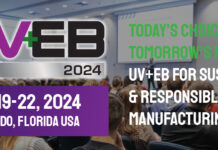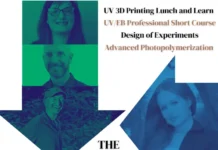Created to recognize innovative start-ups and innovators for ultraviolet and electron beam (UV/EB) technologies, RadTech, the UV/EB industry association announces its RadLaunch Class of 2023. RadLaunch award members will be recognized and celebrated at the upcoming BIG IDEAS for UV+EB Technology conference, March 6-8, 2023 in San Diego, CA.
RadLaunch thanks our awards chairs Dr. Darryl Boyd, Research Chemist – US Naval Research Laboratory, and Co-Founder and Senior Scientist for Science Made Simple; and Mike Idavacage, Radical Curing LLC.
“The RadLaunch class of 2023 is exceptional, offering a wide range of technology, from new bio-materials to a novel way to combine DLP and SLA curing for additive manufacturing to an innovation in Smart Glass to an all-in-one system to make 3D Printing easier to implement in a dental lab,” says Idacavage.
The RadLaunch Class of 2023
Kinetic Glass, Smart Glass Labs
The problem with many current smart glass offerings is that the growth of the market has been anemic and current technologies are neither fully sustainable nor do they adapt to sustainable manufacturing methods. At the same time, many customers, real estate owners and occupants are not satisfied with the comfort nor the features of the current offerings. Kinetic Glass, also known as switchable smart glass, is a form of glass invented by Smart Glass Labs (SGLabs) that allows on-demand opacity (privacy) and light control using minimal energy. As the product enables privacy and light control, it is desirable for use in a variety of applications, such as windows, doors, partitions, and skylights.
According to SGLabs, this novel product meets the demands for sustainability, and the need for providing comfort and lively views to the end-user–and at the same time, will help mitigate some of the effects of climate change due to its ability to act as an IR barrier. Because of the high value add-on of Kinetic Glass, it increases the overall real and perceived value of the property for the real estate investors and building owners.
UV photopolymerization is one of the core technologies of SGLab’s Kinetic Glass. The UV process is a key and necessary step to ensure the durability of the Kinetic Glass. By testing and adapting the use of various UV materials and UV processes, SGLabs can ensure superior aesthetics, seal protection and structural stability, for the next generation of dynamic glass. The potential customers for the Kinetic Glass are mid-scale window and door manufacturers and early adaptors in the residential and commercial markets located in the United States.
Axtra3D, Hybrid PhotoSynthesis (HPS)
Hybrid PhotoSynthesis (HPS) technology is a potentially transformative hybrid light engine solution for Photopolymer Additive Manufacturing. Laser and DLP are two of the traditional light engines used to cure photopolymers for 3D printing, but each comes with tradeoffs. Lasers offer high accuracy, surface quality and scalability but lack print speed. DLP offers a high print speed but lacks the same accuracy. For the first time, HPS offers the combined advantages of the two light engines, DLP and Laser. HPS brings together the energy from the two light sources and creates a harmonized light engine that unifies every value, including wavelength, power, curing time, and simultaneous operation. The result is that HPS eliminates the tradeoffs between DLP and SLA and offers the combined advantages of DLP and SLA.
These advantages include extremely high surface quality, accuracy, print speed, fine resolution and a scalable print area without loss of resolution or speed. “In our HPS technology, the DLP and Laser operate simultaneously, at the same wavelength, and deliver the same energy density. The result is that the standard DLP and/or Laser printing materials can be used in HPS without the need to develop new materials exclusively for this technology. In short, HPS offers Injection Molding quality using AM. ” The company reports that RadLaunch may best help with technology information and networking–as HPS technology evolves, it is intended to extend applications into areas outside Additive Manufacturing.
Mogassam 3D, Special Emerging Market Award
With offices in Cairo, Egypt, Mogassam 3D is developing an ‘all-in-one’ 3D printing platform which integrates the print, wash, and cure steps into a single automated workstation for dental offices. Through the use of automatic processing and assistive AI design elements, Mogassam 3D has made 3D printing accessible to a larger audience of dental offices with limited DFAM (design for additive manufacturing) know how. Furthermore, by automating the process, Mogassam’s hardware is able to help minimize user error and has enabled private dental offices to achieve higher rates of success and better financial returns. Their initial target markets have been chair-side printing in North Africa and the Middle East, where they have already seen great success. In the coming years, they are looking to expand their technology into the United States.
Eastern Michigan University, Special University Award
Prof. Vijay Mannari, Director of the Coating Research Institute (CRI) of Eastern Michigan University has established a rigorous research program with a substantial focus on developing sustainable polymeric materials and processes for advanced coatings. The CRI is dedicated to providing solutions to some of the tough problems facing the coatings industry.
In recent years the CRI has focused on the development of environmentally sustainable polymeric materials and processes for UV-cure coatings. Dr. Mannari’s research group has developed sustainable bio-renewable derived UV oligomers, water-based UV-curable polyurethane dispersions with high bio-renewable contents, and dual-cure systems using click chemistry, to name a few. His recent work on UV-initiated Organic-Inorganic Hybrid (OIH) coatings and thin films by sol-gel mechanism have been awarded a U.S. patent 11,414,524. Building on this invention, the Mannari research group is now developing prototype coating systems for exploring applications in automotive, aerospace, additive manufacturing (AM), and in the battery space. UV-curing technology offers immense opportunities for reducing the carbon footprint of many industrial coating operations. “Guided by the principles of green chemistry and engineering, our research group is combining strengths of bio-renewable materials, efficient crosslinking chemistries, and novel processing techniques for developing a platform for sustainable materials that will advance UV-cure technology and enhance the sustainability of industrial products,” says Prof. Mannari.






